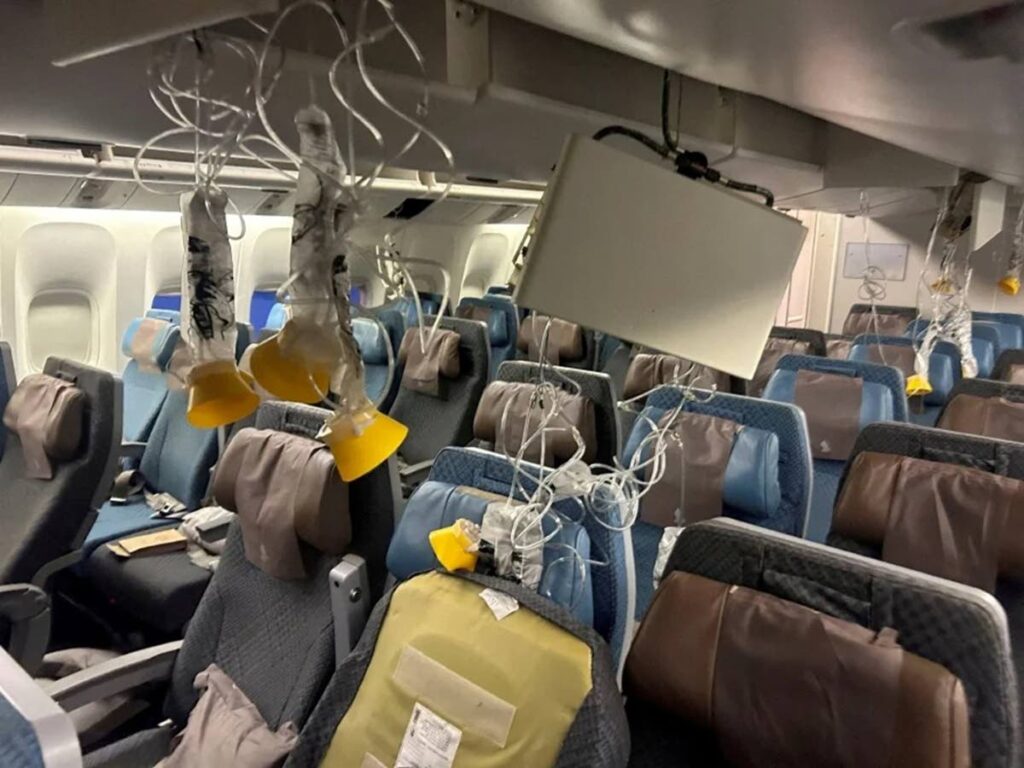When turbulence can be fatal

On May 21, a Boeing 777-312ER operating Singapore Airlines Flight SQ321 from London's Heathrow Airport to Singapore's Changi Airport with 229 people on board encountered severe clear-air turbulence (CAT) over the Irrawaddy Basin, Myanmar, at an altitude of 37,000 feet, approximately 360 nautical miles from Bangkok.
Cabin attendants were serving breakfast when the aircraft encountered the CAT, causing passengers with their seatbelts unfastened and unsecured objects to become airborne inside the cabin.
The aircraft subsequently made an emergency landing at Suvarnabhumi Airport in Bangkok.
One passenger died, and 104 others were injured, with 20 people hospitalised in intensive care units.
The accident was Singapore Airlines' first fatal aviation accident since the crash of Flight SQ006 in October 2000 at Taiwan’s Taipei-Taoyuan International Airport.
On May 26, six passengers and six cabin attendants suffered minor injuries after a Boeing 787-9 Dreamliner, Qatar Airways flight QR017 from Doha to Dublin, encountered CAT while flying over Turkey at 36,000 feet. At the time of the incident, passengers were having dinner and some had their seatbelts unfastened.
The flight continued to Dublin airport and landed safely. Eight of the injured people were taken to hospital for further treatment.
CAT is the turbulent movement of air masses without any visual clues such as clouds. It is caused when bodies of air moving at high speeds collide, causing rapid horizontal and vertical jolting movements of air. The atmospheric region most susceptible to CAT is at altitudes between 23,000 and 39,000 feet, where the troposphere meets the tropopause.
Earth’s atmosphere consists of five layers. The troposphere is the lowest layer of the atmosphere. It contains 80 per cent of the total mass of the atmosphere and 99 per cent of the total mass of water vapour and aerosols. From the surface of the earth, the average height of the troposphere is 59,000 feet in the tropics, 56,000 feet in the middle latitudes and 20,000 feet in the high latitudes of the polar regions.
The tropopause is the atmospheric boundary that demarcates the troposphere from the stratosphere, which are the lowest two of the five layers of the atmosphere. The tropopause is a thermodynamic gradient-stratification layer that marks the end of the troposphere.
Here CAT is most frequently encountered in the regions of jet streams.
Jet streams are fast-flowing, narrow, meandering air currents. The main jet streams are near the altitude of the tropopause and are westerly winds, that is, flowing from west to east. Jet streams may start, stop, split into two or more parts, combine into one stream, or flow in various directions. The strongest jet streams are the polar jets around the polar vortices between 30,000 and 39,000 feet above sea level.

The northern and southern hemispheres have polar jet streams. The northern hemisphere polar jet streams flow over the middle-northern latitudes of North America, Europe, Asia and the oceans, while the southern hemisphere polar jet streams mostly circle Antarctica all year round.
Jet streams are the product of two factors: atmospheric heating by solar radiation and the action of the Coriolis force acting on those moving masses.
The Coriolis force is caused by the earth's rotation from west to east. Other jet streams also exist.
During summer, easterly jet streams can form in tropical regions of the northern hemisphere where dry air encounters more humid air at high altitudes.
Meteorologists use the location of jet streams in weather forecasting.
The main commercial impact of the jet streams is in air travel, as flight times can be significantly affected by flying either with the flow or against a jet stream. Airlines seek to fly with the jet streams to achieve reduced flying times and consequent fuel savings.
The North Atlantic Tracks are a structured set of transatlantic flight routes that stretch from eastern North America to western Europe across the Atlantic Ocean in the North Atlantic airspace region. These heavily travelled routes are used by aircraft flying between North America and Europe between the altitudes of 29,000 and 41,000 feet. The use of NATS is one example of how airlines and air traffic control work together to utilise the jet streams.
Airborne weather detection is based on the reflectivity of water droplets.
The weather echo generated by the aircraft radar system appears on the cockpit’s navigation display with a colour scale that goes from red (high reflectivity) to green (low reflectivity).
The radar echo returns vary in intensity as a function of the droplet size, composition and quantity. For example, a water particle is five times more reflective than an ice particle of the same size.
CAT can be hazardous to the safety of air travellers, and cannot be detected by the aircraft radar system which provides the pilot with information to avoid adverse weather such as thunderstorms. CAT is not visible to the naked eye.
To mitigate the hazards of CAT, airlines introduced inflight procedures such as advising passengers to keep their seatbelts fastened while seated even when the "fasten seat belt sign" is off.
Passengers are also advised not to congregate in the aisles or in the area of the toilets. The latter is very difficult to manage, as most people use the aircraft toilets after a meal or after
drinks. During long flights, this results in a queue, with passengers standing unrestrained in the aisle waiting to use the toilet. On large transport aircraft, turbulence at the rear of the aircraft, where most toilets are normally located, can be much greater than at the front.
Researchers have predicted that with climate change, there could be an increase in CAT incidence. Likewise, radar technologists are feverishly working to develop aircraft radar systems that can detect CAT.
As a result of the recent Singapore Airlines and Qatar Airways CAT occurrences, national civil aviation safety regulators will more than likely issue additional guidelines for the use of seatbelts and the security of galley equipment while flying through known zones of previous CAT occurrences.

Comments
"When turbulence can be fatal"